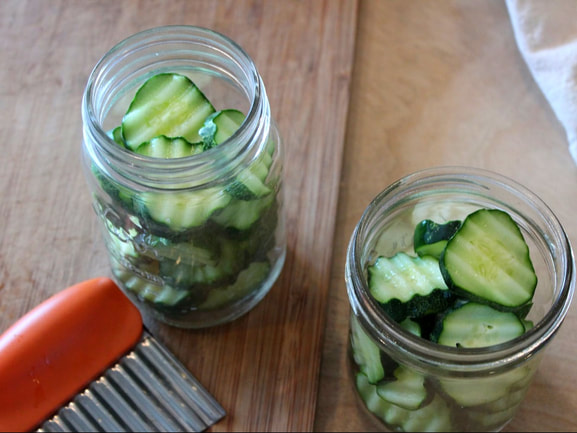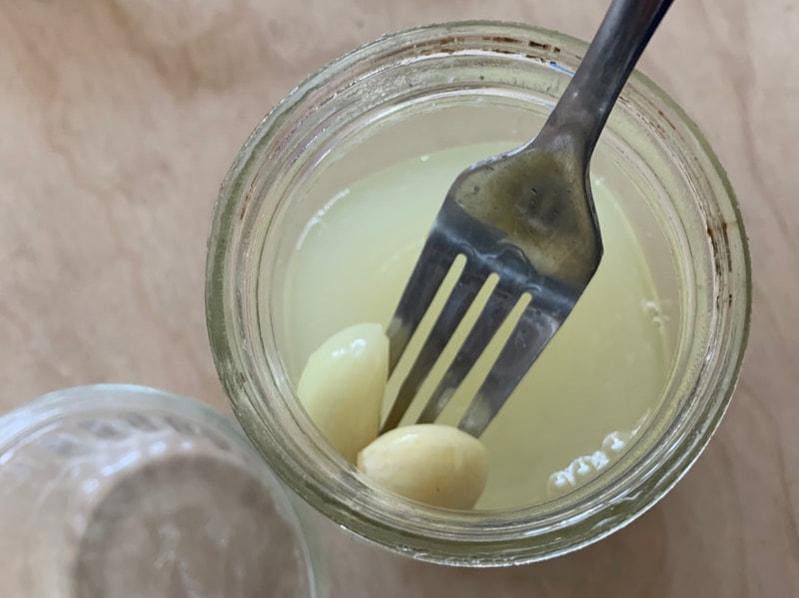Preserving your cucumber harvest Pickles are one of the best items to come out of the garden in my opinion! Years ago, pickling for me was a tedious task that had somewhat unreliable results. Nothing more disappointing than a mushy pickle after you have invested several hours in a hot kitchen and waited weeks to try them! So when I stumbled upon fermented pickles I rejoiced! No more hot kitchen, no more hours of labor prepping and canning, and higher nutritional value. Sign me up! Canning Pickles Versus Fermenting PicklesPickles by definition are "preserved in a solution of brine or vinegar." This acidic brine gives pickles their pucker or sour flavor. By creating a PH below 4.6 and submerging the vegetables in the liquid brine, most negative bacteria is eliminated. It is the acidic and anaerobic environment that allows vegetables to be preserved for long term storage. When I pickle cucumbers in this way, I will pack the cucumbers into jars and water bath can them, hence the long hours and hot kitchen. The water bath canner kills the bacteria, both good and bad, in order to create the sterile environment needed for long term storage. Fermentation is another method to acidify vegetables and create pickles. Submerging vegetables into a salt brine prohibits bad bacterial growth and allows the good microbes to transform the carbohydrates into acid. The microbes do all the pickling, reaching our PH goal of less than 4.6. By pickling in this way, there is no need for a water bath canner. You can prepare your pickles in just a few minutes and in just a few weeks on the shelf, you will be enjoying your pickles! The probiotics are kept intact by not processing with heat. After sitting on the shelf for a few weeks, these pickles can be stored in your fridge for months. The colder temperature of the fridge slows the fermentation process so your pickles will not taste too sour. Crunchy pickles only please!When I set out to create the perfect pickle my first line of business was to make sure they were crunchy. After some research I found that traditionally people used tanins to give their feremented veggies that crunch we all love. You can find tanins in several places. In my recipe I use loose leaf black tea. It is important to find organic tea to avoid tainting your pickles with pesticides and herbacides. You can also use bay leaves, grape leaves or oak leaves which are also great sources of tanins. Although the black tea can tint the water and the pickles a brownish color, I'm not bothered by that. I find the bleack tea to be the easiest, least expensive to use and I always have some on hand. I plan on trying the bay leaves next since they are also plentiful in my pantry. Fermented Garlic Dill PicklesIngredients:
Slice the pickling cucumbers. I like to use a wavy slicer like the commercial pickles in the store. Coarsely chop about 4 cloves of garlic. Feel free to adjust the garlic to your taste. Add several sprigs if fresh dill for the classic pickle flavor. Add one tablespoon of loose leaf black tea, or other tannin containing leaf to the jar for crunchy pickles! Add one tablespoon of salt to two cups of water. Mix to incorporate and pour into jar. Add a weight to jar to keep vegetables submerged. This is not necessary but can be helpful. Top your jar with a pickle pipe or airlock and leave in the pantry for 3-5 days and up to several weeks, depending on the heat. Fermentation happens much faster in the summer than the winter. Once you are ready to enjoy the pickles, pop them in the fridge for a few hours and then enjoy! They will keep in there for months as the fermentation process is slowed dramatically in the colder temperature of the fridge. What other vegetables do you like to pickle?
0 Comments
Your comment will be posted after it is approved.
Leave a Reply. |
AuthorFrancesca, wife and mother of three, eagerly shares day-to-day life on her ten acre farm in northern Colorado. Categories
All
Archives
March 2023
|
|
Copyright © 2022 3 Seeds Farm
Site powered by Canopy Creative Marketing |
|





 RSS Feed
RSS Feed
